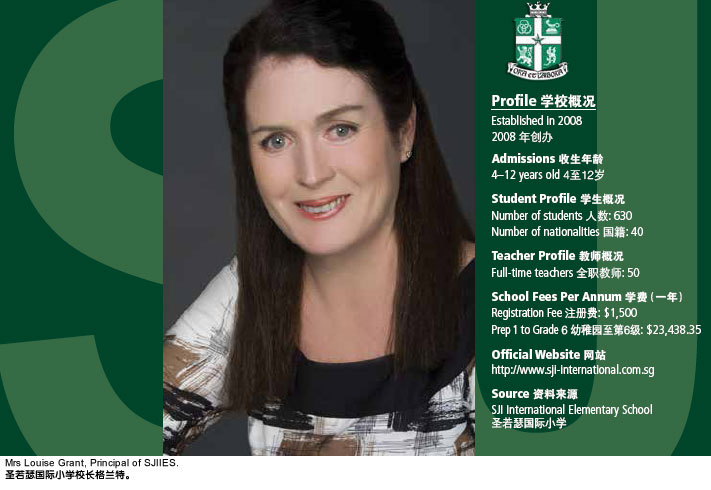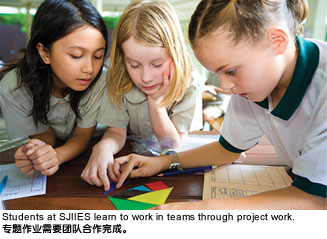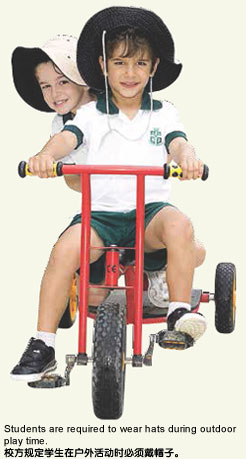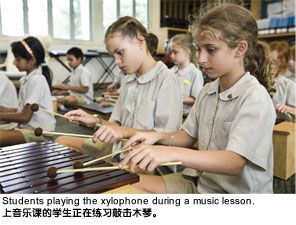
At St Joseph’s Institution International Elementary School, the belief is that if you start with inculcating the right values and virtues, academic growth will follow.
Every week, students at St Joseph's Institution International Elementary School (SJIIES) learn about a virtue which their teachers identify. They also get "wow cards" and "ops cards" for how they behave in school.
In Singapore, values education is increasingly in the spotlight, but at SJIIES it has always been at the heart of what it does, in line with its mission as a Catholic school. Its Principal, Mrs Louise Grant, strongly believes that once the foundations of a values education are in place — where children have been supported in their personal and social growth — academic growth will follow.
"It all starts with building character in children, and it wouldn't matter if we have an excellent Maths or Chinese curriculum if we don't have a happy, positive, respectful and co-operative environment. The best environment for children is one in which they feel safe, valued, challenged and are progressing in," Mrs Grant said.
The Virtues Project
The School does not just talk about inculcating values. Indeed, values education is strongly embedded in what the students see and hear every day through the Virtues Project, which is developed around speaking the language of virtues and setting clear boundaries.
"One of the ways we teach virtues is to have a Virtue of the Week," Mrs Grant said. "It goes into the newsletter for parents so that they can reinforce the virtue at home, and every morning at assembly we will talk about what the virtue means and how we can practise that virtue. This approach helps students to speak the language of virtues, to acknowledge each other for virtues shown during the weekly reflection time and to adopt the language also when solving conflicts. For the children, it is especially important for them to receive positive reinforcement when practising the virtues as effective praise and compliments bring out the best in everyone."
 A total of 52 virtues, including obvious examples like kindness, perseverance and humility, fill up the year. A total of 52 virtues, including obvious examples like kindness, perseverance and humility, fill up the year.
To further strengthen values education, SJIIES has four codes of behaviour: self-discipline, courtesy, responsibility and respect. With positive actions, the student is given a "wow card" with the particular virtue that was exhibited written on it. Cards given to students are placed in a box and during assembly on Fridays one card is picked at random. The class of the person whose card is chosen will then be given free time to celebrate the virtue that was shown.
When a student behaves in a manner which infringes one of the codes, he or she will be given an "Oops card", and asked to have a talk with a teacher on what virtue would help him or her in future. If something more serious occurs, the student will be asked to reflect and write about what virtue could be used when faced with a similar situation.
"It's also about conflict resolution. We have something called the talking corner, where students can go when they have a conflict with someone, and there's a protocol on how to talk through the problem. They first have to recognise the virtue in each other, then say how they felt during the conflict and finally they need to think about what they can do to solve the issue," Mrs Grant added.
Values Attraction
Mrs Grant thinks that the focus on values is a key attraction for parents and that those who choose to send their children to SJIIES are very much aware of the importance of a values-based education.
"we tend to attract three types of families. Firstly, people who are long-term Singapore residents who appreciate all that Singapore has to offer, and who are comfortable within the Singapore context and the culture of the School. Secondly, people who may have arrived a few years ago, and have since started making Singapore their home. Thirdly, we have people who may be new and are on the lookout for a school providing an international experience in the context of Singapore. These are those who have the opportunity to move with their work to Singapore, and are consequently keen to immerse themselves in the culture, rather than go to a school which follows their home system.
"we get a lot of long-term residents, thus we don't have that many children leaving each year. In fact, our turnover rate of less than ten per cent is very unusual for an international school. We also have students where one parent may be Singaporean and the other an expatriate, so it's kind of a nice place where they can experience both cultures," Mrs Grant said.
As a result of the growing interest received from the community, the School has recently hosted a symposium, Building Children of Character, which provided specific insights into the practices and benefits of a values-based education. Mrs Grant is hopeful that this will mark the first of many valuable opportunities to talk about the inclusion of a values-based education in the local schools system.
"It's a very inspiring programme, and we're interested in exploring how it may be relevant to the local schools, because recently there has been a lot of talk in the local system about paying more attention to a values-based education. And of course, we're learning as we go along too."
A Local-International School
The mix of cultures extends beyond the student demographic to the school curriculum. SJIIES strives to incorporate the best from the East and the West to make learning more meaningful for its students.
 The School uses the International Primary Curriculum (IPC) so it has the freedom to introduce Singapore Math as well as Chinese as a compulsory second language. The School uses the International Primary Curriculum (IPC) so it has the freedom to introduce Singapore Math as well as Chinese as a compulsory second language.
"we use Singapore Math as it's the best syllabus for primary school learners, while Chinese is the only second language we offer. We're committed to every child being proficient in the Chinese language by the time they graduate, because it's agreed worldwide that a great benefit in setting children up for success in the future is for them to be fluent in Chinese," Mrs Grant said.
To tailor its Chinese language programme to the varying abilities of students, there are three courses on offer: Chinese as a Foreign Language (Foundation), Chinese as a Foreign Language (Intermediate), and Chinese Language.
The Foundation course is for students who are new to Asia and who have no prior experience with the Chinese language whilst the Intermediate course is for students who have already been learning it for a period of time. A number of the older children who have been at SJIIES for some years are studying at this level. The Chinese Language course is for students who come from a Chinese-speaking background or who have been exposed to Chinese as a foreign language from a very young age.
Students learn Chinese every day, and the School tries its best to include it in all aspects of school life. Chinese posters and phrases are displayed around the School, and Chinese songs are sung during assemblies. As the founding Principal, Mrs Grant has witnessed how students have become adept at speaking, reading and writing Chinese after spending some time at the School.
In the local context, the School is rooted in the Singapore culture. Students celebrate all the local festivals, and there is a balance between having fun and a strong work ethic. "Learning is fun at the School, it's enjoyable and it's engaging, because we know that's the way children learn best," Mrs Grant said.
A Fun School Environment
 "we are a learning-focused school, and we have discussions with the children about what helps them learn best, how they learn best and what stops them from learning — that's a big part of the conversation we have with the children, to know themselves as learners," said Mrs Grant. "we are a learning-focused school, and we have discussions with the children about what helps them learn best, how they learn best and what stops them from learning — that's a big part of the conversation we have with the children, to know themselves as learners," said Mrs Grant.
In Mrs Grant's opinion, there is little point in an over-emphasis on learning knowledge because it quickly becomes obsolete in a fast-changing world. The more important task is to help students become effective learners. At the start of every year, students experience a three-week unit called Learning about Learning. At a basic level, they learn how the brain functions and what they can do to help the brain work optimally. In the higher grades, students take surveys to find out their learning style and they are introduced to the theory of multiple intelligences. There are learning points for the teachers too, in that they discover the learning style of each of their students and how to best facilitate learning for them.
Learning is optimised when connections are made, and a great deal of attention is paid to this at SJIIES. Part of helping students to make connections is to help them understand how things are similar, or getting the "a-ha" moment when a connection is made between two previously different concepts.
Students experience six IPC units a year, and there are entry and exit points for each unit. About entry points, Mrs Grant explained, "A new unit starts with what we call an entry point — something that will really enthuse the children about what's to come. For example, the five-year-olds from Prep 1 had a treasure hunt recently as their entry point. They were out around the School looking for clues and as a continuation, for one month or so, whatever they learn in their different subjects will revolve around the theme of treasure."
Exit points, which mark the end of a unit, are equally important. "I was in Grade 3 and the nine-year-olds were having their exit point for a unit called Time and Place. This meant that they were working on an attention-grabbing, exciting focus that would sum up all they had learnt. They made travel brochures of places around the world for their writing assignment; then they brought props, dressed up, the parents came in and we had a travel fair. The children created the brochures for a real reason, and wherever possible, we make the learning authentic.
"It's child-centred here, and I'd like to think that rigour and high expectations are also part of the culture of the School," Mrs Grant concluded.
|